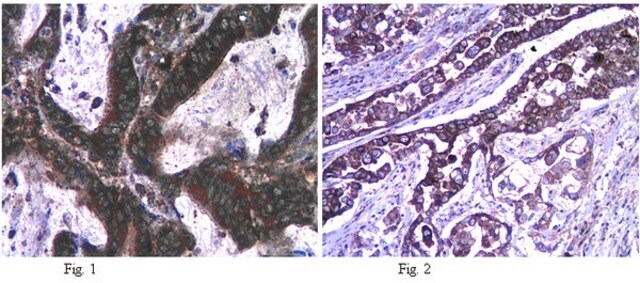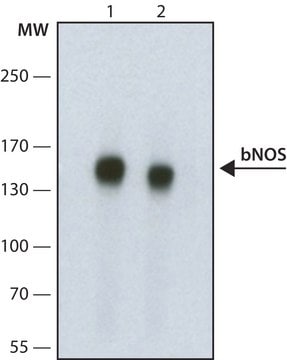General description
In humans, nitric oxide synthase 1 (NOS1) or neuronal nitric acid synthase (nNOS) is localized to the sarcoplasmic reticulum. The gene encoding it is, localized on human chromosome 12q24.22. In rats, the protein is present in perivascular nerves supplying the cerebral vasculature. The gene encoding it is localized on rat chromosome 12q16.
The nitric oxide synthase (NOS) isoform found in neurons is a 150-160 kDa protein. It is also termed brain NOS, NOS1, neuronal NOS (nNOS or bNOS, neuronal constitutive NOS or Ca2+-regulated NOS (cNOS, ncNOS). The nNOS or NOS1 gene is mapped to human chromosome 12q24.22. bNOS is present in skeletal muscle, central, peripheral neurons and neuronal cell bodies. Human bNOS and endothelial nitric oxide synthase (eNOS) share 52% amino acid identity, and rat and human bNOS share 93% amino acid identity. Structurally NOS exists as homodimers. The N-terminal region comprises heme and calmodulin binding sites. The reduced nicotinamide adenine dinucleotide phosphate (NADPH) and flavins binding regions are localized in C-terminal region.
Specificity
The antibody is specific for nitric oxide synthase (NOS) derived from brain. It does not recognize NOS derived from activated macrophages (iNOS) and endothelial cells (eNOS).
Immunogen
synthetic peptide corresponding to nitric oxide synthase (NOS) of rat brain origin (bNOS, amino acids 1409-1429) conjugated to KLH. The immunogen sequence differs from the human bNOS by a single amino acid residue.
Application
Anti-Nitric Oxide Synthase, Brain (1409-1429) antibody produced in rabbit has been used in:
- immunoblotting[1]
- immunostaining[1]
- immunohistochemistry
- immunofluorescence
- immunocytochemistry
Biochem/physiol Actions
Nitric oxide synthase (NOS), brain (nNOS or bNOS) mediates long-term regulation of synaptic transmission (long-term potentiation, long-term inhibition). It catalyzes the production of nitric oxide (NO) from L-arginine. The NO mediates neurovascular coupling and is associated with neuronal plasticity and pain signal transmission. nNOS regulates blood pressure, relaxation of smooth muscle and vasodilatation via peripheral nitrergic nerves. nNOS is complexed to dystrophin. However, in Duchenne muscular dystrophy (DMD), the skeletal muscle sarcolemma is devoid of nNOS.
Physical form
Solution in 0.01 M phosphate buffered saline, pH 7.4, containing 15 mM sodium azide
Storage and Stability
Store at 2-8 °C for up to one month. For extended storage, solution may be frozen in working aliquots. Repeated freezing and thawing, or storage in "frost-free" freezers,is not recommended. If slight turbidity occurs upon prolonged storage, clarify by centrifugation before use.
Disclaimer
Unless otherwise stated in our catalog or other company documentation accompanying the product(s), our products are intended for research use only and are not to be used for any other purpose, which includes but is not limited to, unauthorized commercial uses, in vitro diagnostic uses, ex vivo or in vivo therapeutic uses or any type of consumption or application to humans or animals.







